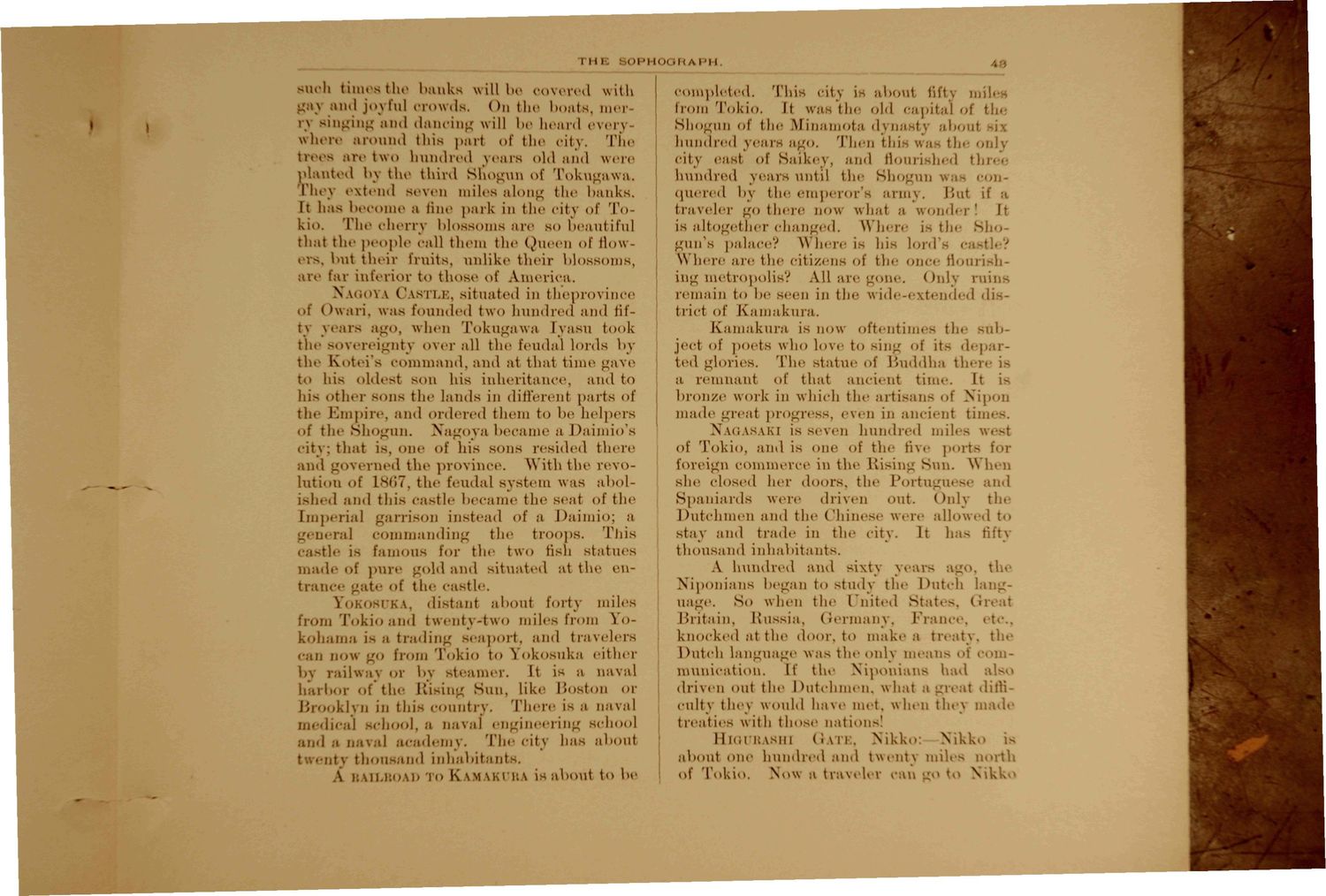| |
| |
Caption: Sophograph - 1891
This is a reduced-resolution page image for fast online browsing.

EXTRACTED TEXT FROM PAGE:
I 111 () p I 0< . H A I ' M such times t ho banks w ill be co>ered with ni.l j<>\ t'ul crowds. < > the boats, mern Bingii and dancing w ill be heard e\ e n w bere around this part of the city. The H are fcwo hundred \ ears old and w ere (anted l«\ the third Shogun of Tokugawa. Fin \ extend seven miles along the banks. It lias b MII«' a tin.' park in the city of To< rhe cherry blossoms are so beaut iful that the people call them the Queen of flowis, I'ut their fruits, unlike their blossoms, an r inferior to those of America. \ \ >\ \ CAM I.I.. situated in theproi ince • Owari, was founded two hundred and fifty years ago, when Tokugawa [yasu took tl sovereignty overall the feudal lords l>v tl K - command, and at thai time gave oldest son his inheritance, and to 11i — other Bons the lands in different parts of • th< Empire, and i >rd< I t hem to be helpers • tli> s | in. N"agoyabecame a Daimio's city; that is. on.' of his sons resided there an governed the province. With the revolution of 1807, the f.udal system was aboli and this castle became the seat of the Imperial garrison instead of a Daimio; a ral commanding the troops. This i«tle is mous for the two fish Btatues n. pure gold and situated at t he enai te of the castle. V \. disl nt about forty miles om Tokio and twenty-two miles from l o kolian - t r.H lii tp< MI . and t ra \ elers from Tokio to Xokosuka either by railv. or by Bt r. It is a naval h th- Rising Bun, like Boston or J! >khJI in tin countrv. There is a aa\al IJ, chool, a ii.iv&] engim ring school nd ocad< m y. Tin city has about thou '' I inhabitants. • * completed. This city is about fifty mile* from Tokio. 11 u i the old capital i Shogun of t lie M inamota d s m uI hundred years ago. Then thin 11, ml city east of Saiki i ad floui I thr< hundred years until the Shogun \ conquer* d by the empei or arm^. But it' traveler go there DOW what a on ! is altoget her changed. Where t he gun's palace? W here is his lord Where are t h. it iz< i of 1 he one- flourishing metropolis? All are . (>nly rail remain to be seen in the w ide-extend< d d tiiet of Kamakura. - K a ma k lira is now oft •-lit ini• tin j j j I A j : ULHOAD TO KAMAKI l; \ ifl 0 b o u t t o b e jeel of poets w ho lo\ i to sing of it- i ted glories. The statue of Buddha tl is a remnant of that ancient time. It ibronze work in which the arti Nipon made great progress, even in ancient tin. NAGASAKI is seven hundi I mil west of Tokio. and is one .>f the fii i portr foreign commerce in the Risii 3 in. When she closed her doors, tin Portuguesi I Spaniards were driven out. Only tin I Dutchmen and the (Shim wi allow I tstay and trade in the city. It has tiftthousand inhabitants. A hundred and sixty years a », tin Niponiaus began to study the Dutch language. So when th< I United States, Gn t Brita in, Russia, (lermanj . Franci . knocked at t he do . t o make a treat \. tin Dutch language was the only means niiMinie.iti.m. If the Niponians id als< .In \ >'ii < »ni the I )iitehinen, what it dilV «1 1 \ ih.\ would have met, when tin \ mad -11 t real ies w it h t hose oat i u < BlQUIiASHl CTATE, Niki \ik! i about i 'in- hundred • nd t« ent\ miles - h of Tokio. \< > ii t r.i \ i w Nikk
| |